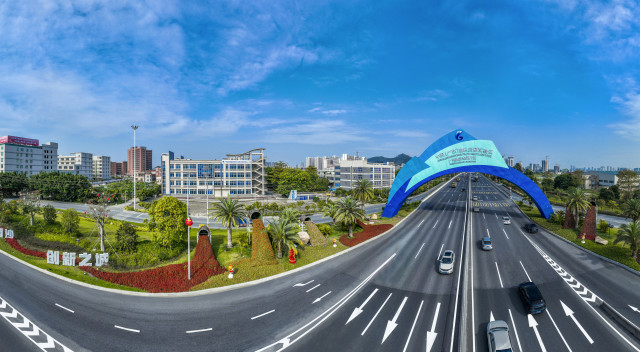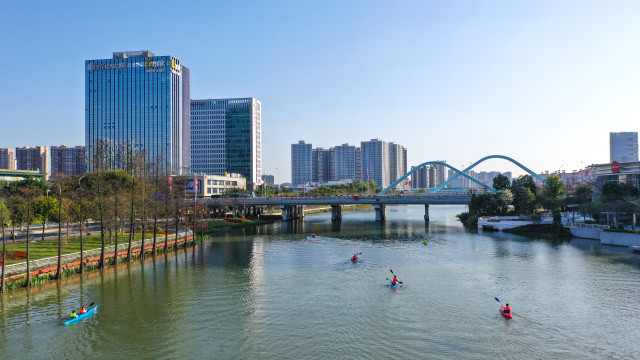Kelvin Wong, a Hong Kong native and Deputy Chief Engineer of Arup Group, has participated in the design of many large-scale engineering projects in Guangzhou’s Nansha. He said that some of the common issues in urban development, such as traffic congestion and pollution have been taken into consideration in the design planning of Nansha. “I believe Nansha will become a green and smart area, which will make it suitable for living and working,” said Wong.
The Outline Development Plan for the Guangdong-Hong Kong-Macao Greater Bay Area (GBA) indicates that China will promote the urban planning and construction of Guangzhou’s Nansha to a high standard, improve its ecological environment and highlight it Lingnan culture, water town culture, as well as marine culture.

(Nansha has advanced transportation networks/photo provided to GDToday)
One-hour-life circle dream comes true
Kelvin Wong has participated in numerous major construction projects in the Chinese mainland since 2001. He has a deep understanding of the development and changes of major cities in Guangdong since he joined the construction projects such as KK 100 in Shenzhen and Guangzhou IFC. “The projects here are large in volume and require high standard. In addition, the project design is very innovative,” he said.
In 2019, as the GBA accelerated its infrastructure construction, Wong received more projects in the GBA. Thus, his decision to move from Hong Kong to Shenzhen was a further indication of his devotion to the projects of the GBA.
Kelvin Wong believed that the GBA has been changed from an independent development of loosely-connected cities to an interconnection and coordination of modern metropolises through a strong transportation network. Taking Nansha Station (under construction) as an example, it will introduce 8 railway lines, including the Guangzhou-Zhongshan-Zhuhai-Macao High-speed Railway and Nansha-Zhongshan-Zhuhai Intercity Railway, which will connect cities in the GBA, including Hong Kong, Macao, Zhuhai and Zhongshan.

(Nansha has a dense water network/photo provided to GDToday)
“Nansha is located at the geometric center of the GBA. After the transportation networks are completed, it will be very convenient to go to Shenzhen, Zhuhai, Guangzhou, Hong Kong, and other cities. The one-hour life circle will become a reality. Living here, you will find it easy to travel around different places for work or gathering with friends,” said Wong enthusiastically.
Nansha has also made great efforts to promote green development. Arup Group, for which Kelvin Wong works, provides consulting services of infrastructure projects for Pearl Bay Launching Area Phase 2 (the Tip of Hengli Island), including underground-space, roads, bridges, and landscape projects. Wong has also participated in the fire control design of the Hong Kong University of Science and Technology (HKUST) (Guangzhou).
According to Wong, the engineering consultant team cooperated closely with the Pearl Bay Administration. From the beginning of this project, they connected with personnel from diverse professional backgrounds and scientifically planned the overall landscape and ecological pattern of the area.
“As Nansha has a developed water system and a dense water network, we will pay attention to the group characteristics of bridge design. Bridges are not only used for transportation, but they are part of urban public spaces,” Wong pointed out. He introduced that in the design of underground space, the team places a lot of effort into underpass design, which eases ground traffic and makes it easy for citizens to connect with other regions.
High-quality and innovation have become keywords of GBA construction
Wong regards high-quality and innovation as the keywords of the GBA construction. Wong continued, “Nansha is a new development area, and it relies on the strong foundation of technical research from HKUST (Guangzhou). We have reserved a certain margin when designing and taken advantage of new technologies, one of which is autonomous driving.”
“For example, the Nansha No. 23 Self-driving Bus has officially been placed into operation as of January 1 of this year. The bus drives at speeds up to 30km/h over an 8.5km-long route, ranging from the bus terminal of Hengli Metro Station to Lingshan Island Ring Road. Passengers can book a ride through the Nansha Bus Serviceplatform,” he added.

(Hong Kong University of Science and Technology (Guangzhou)/photo provided to GDToday)
As an alumnus of the HKUST, Wong is very proud of the scientific and technological support provided by HKUST (Guangzhou) for Nansha construction projects. In October of this year, the Administrative Committee of the Nansha Development Zone and the HKUST (Guangzhou) signed the Strategic Agreement on Collaborative, Innovative, and Comprehensive Cooperation, to support the HKUST (Guangzhou) to transform itself into a world-class research university and promote the transfer and accomplishment of major scientific and technological achievements in Nansha.
Wong stressed that many engineering projects in the GBA have advanced higher requirements for quality. “Such an innovative environment attracted me to work in the mainland cities of the GBA and inspired us to explore and practice our crafts,” he said. Wong encourages young people in Hong Kong to explore and seize opportunities in Nansha. He concluded, “As more sci-tech innovative industries settle here, Nansha will be a promising place in the future.”
Author丨Nina, Zhang Shiyu
Editor丨Wing, Steven, Jasmine, Jerry
















